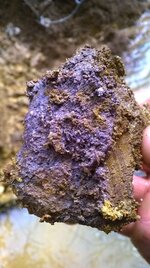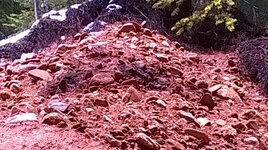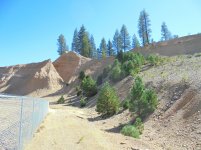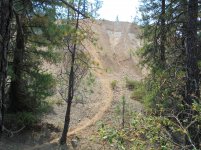Navigation
Install the app
How to install the app on iOS
Follow along with the video below to see how to install our site as a web app on your home screen.
Note: This feature may not be available in some browsers.
More options
You are using an out of date browser. It may not display this or other websites correctly.
You should upgrade or use an alternative browser.
You should upgrade or use an alternative browser.
If you've posted something, and it disappears, don't make a big deal out of it in another post! (You've probably violated some rule below!)TreasureNet - Rules
& if it Continues we reserve the right to remove the Problem poster.
& if it Continues we reserve the right to remove the Problem poster.
- Dec 27, 2012
- 560
- 1,451
- Detector(s) used
- whites mxt, tesoro lobo super trac., monster1000
- Primary Interest:
- All Treasure Hunting
i made a simple attempt at humor , obviously it didn't work for everyone , sorry , but on the other hand , the part of picture where material is smeared and so is the purple topping , it does not appear to be any kind of solid , which fluorite is usually pretty solid , and usually forms on solid surfaces , you pic looks like a chunk of mud or clay , so I'm not doubting you , did not mean to hurt your feelings , i wish it was worth a million bucks for you , but it still looks like old cake , don't eat it , lol ,
(that is a joke not an insult )
(that is a joke not an insult )
StreamlineGold
Sr. Member
- Apr 21, 2013
- 330
- 205
- Primary Interest:
- All Treasure Hunting
In Colorado there are a few flouride/gold veins. The pic however does not look crystalline..fluoride is a crystal its probably not going to stain that clay type of material. I really dont have anything helpful beyond that sorry. It doesnt look like anything natural I have seen.
Gravelwasher
Hero Member
Gold and purple can be related, when gold is heated it can leave a purple streak or residue. I think Ben Franklin played with gold between two glass slides and passed a current through and was left with a purple stain on his glass.
Hopefully a huge boulder of gold got vaporized and left a trail of purple..lol
Hopefully a huge boulder of gold got vaporized and left a trail of purple..lol
arizau
Silver Member
- May 2, 2014
- 2,516
- 3,941
- Detector(s) used
- Beach High Banker, Sweep Jig, Whippet Dry Washer, Lobo ST, 1/2 width 2 tray Gold Cube, numerous pans, rocker box, and home made fluid bed and stream sluices.
- Primary Interest:
- Prospecting
If I am not wrong I think mineral crystals, flourite included, are formed under intense pressure and heat. Maybe that deposit was formed in an open chamber and that it was vented enough to where the mineral formed as a residue (precipitated out) in a pool of highly concentrated solution that evaporated(?). It would be interesting to see it under magnification and maybe that would show microscopic crystals rather than the norm.
Last edited:
OP
OP
ghostminer
Guest
- Thread starter
- #46
Might be worth a dig under that stuff. Our geologist said it could be indicative of a high grade ore deposit of some sort. Now i'm more curious than ever.
If I am not wrong I think mineral crystals, flourite included, are formed under intense pressure and heat.
You are not wrong...but also not completely right

Geological processes involving mineral formation can be extremely complex. A lot of gold deposits are formed in fractions of a second during earthquakes along a fault due to the drop in pressures making the mineralized solution crash out onto the walls of the fault. Some evaporite mineral crystals will happily grow at regular atmospheric pressures and temperatures... Some other minerals form in molten magma (or lava) as it cools - olivine's crystal structure actually becomes unstable under high pressures: https://en.wikipedia.org/wiki/Olivine#High_pressure_polymorphs
Crabs
Jr. Member
Really.https://en.wikipedia.org/wiki/Newbery–Vautin_chlorination_process
Leaves purple residue.
You need to look into this.
This process was used in areas where the gold was combined in sulfides.
I know for a fact it was used the GrassValley/Nevada City area and there are areas where the ground is bright purple from the discarded residues.
I'll be dollars to donuts there was roasting/ pressurized chlorine extraction facility where you are digging.
'Crabs
OP
OP
ghostminer
Guest
- Thread starter
- #49
Nope. No the entire history there.
Goldwasher
Gold Member
- May 26, 2009
- 6,082
- 13,241
- 🥇 Banner finds
- 1
- Detector(s) used
- SDC2300, Gold Bug 2 Burlap, fish oil, .35 gallons of water per minute.
- Primary Interest:
- All Treasure Hunting
Massive gravel deposits...doesn't make sense that a vein of fluoride crystals would be formed there.
"the bluffs" are they bedrock? What type?
"the bluffs" are they bedrock? What type?
Last edited:
OP
OP
ghostminer
Guest
- Thread starter
- #52
No. At least 60 to 100 ft above bedrock.
Goldwasher
Gold Member
- May 26, 2009
- 6,082
- 13,241
- 🥇 Banner finds
- 1
- Detector(s) used
- SDC2300, Gold Bug 2 Burlap, fish oil, .35 gallons of water per minute.
- Primary Interest:
- All Treasure Hunting
Well that blows the geologists opinion out of the water, as anything you find on the surface is not from the area of your mines. Considering why those gravels are there and where they originated up to 30 million years ago.
OP
OP
ghostminer
Guest
- Thread starter
- #54
The only thing I can tell you is we have hand sampled the base of that bluff & seasonal drainage area in the bluff & have gotten good color in every pan. Definitely needs further exploration. It is way west of our permitted area where the hydraulic activity took place. I am somewhat suspect of that area though. The reason is there is not much sign of any big mining activity at that location. I tend to follow the old timers lead & look at areas they worked for years but never finished. To me that is a better use of capital for a small company & the exploration of new areas can come in later years. It's all about profits & survival at first.
Goldwasher
Gold Member
- May 26, 2009
- 6,082
- 13,241
- 🥇 Banner finds
- 1
- Detector(s) used
- SDC2300, Gold Bug 2 Burlap, fish oil, .35 gallons of water per minute.
- Primary Interest:
- All Treasure Hunting
Traveling the northern gravel deposits. Malakoff N. san Juan Port Wine etc. You can see they left more gravel in place than they worked. In the pits there is material that wasn't fully processed as well.
The top layers were very low grade typically though they wanted to overburden out of their way so they would run from surface to bedrock.
Some pit and face samples are going to have false recent concentration. and will throw more gold than the undug gravel.
When Sawyer went through they still had the means to move all that low pay but, it became a huge hassle to contain the slop.
they also used massive amounts of water to pound cemented gravels before they even tried to get them into the sluices.
It was problematic to move material around a defined pit area. they didn't have heavy motorized equipment and wagons just didn't work.
Even with derricks and the invention of rubble elevators it became very difficult to work those low grade deposits and make money. While managing all the tailings right in the pit area.
There is a reason the sawyer decision made all those pits give up. They could only get so big and deep while the tailings just piled up.
Dredging took over and those pits sat and had time to get localized gold concentrations that have had small ops drooling at the surface and the face and crying once into the virgin gravel.
They created false samples.
For reclamation do they expect you to build back up a thirty foot bank that gets worked?
Just curious.
I would be working very hard on finding the pay layers and the way to work them and just ditch the intermediate low grade.
The reports exist for the elevations of the various wet period runoff deposits that left higher grade layers.
There are places in Placerville where they never even hit the bedrock yet pulled millions.
Though the Placerville quad had a more defined series of channels and the Blue lead that is much richer than the gravels in Plumas or Butte county.
The top layers were very low grade typically though they wanted to overburden out of their way so they would run from surface to bedrock.
Some pit and face samples are going to have false recent concentration. and will throw more gold than the undug gravel.
When Sawyer went through they still had the means to move all that low pay but, it became a huge hassle to contain the slop.
they also used massive amounts of water to pound cemented gravels before they even tried to get them into the sluices.
It was problematic to move material around a defined pit area. they didn't have heavy motorized equipment and wagons just didn't work.
Even with derricks and the invention of rubble elevators it became very difficult to work those low grade deposits and make money. While managing all the tailings right in the pit area.
There is a reason the sawyer decision made all those pits give up. They could only get so big and deep while the tailings just piled up.
Dredging took over and those pits sat and had time to get localized gold concentrations that have had small ops drooling at the surface and the face and crying once into the virgin gravel.
They created false samples.
For reclamation do they expect you to build back up a thirty foot bank that gets worked?
Just curious.
I would be working very hard on finding the pay layers and the way to work them and just ditch the intermediate low grade.
The reports exist for the elevations of the various wet period runoff deposits that left higher grade layers.
There are places in Placerville where they never even hit the bedrock yet pulled millions.
Though the Placerville quad had a more defined series of channels and the Blue lead that is much richer than the gravels in Plumas or Butte county.
Last edited:
OP
OP
ghostminer
Guest
- Thread starter
- #56
Thanks for all that. No, we don't have to build the bluff face back. The area I was talking about with the purple material is a creek bluff. We have no interest in that area for now. We are permitted in the mining district 1/2 mile east of there. There is an exposed faultline richer than snot. Then there is another mine 2000 ft east which was partially hydraulicked with 1 million yards of pay left over in the gut of the channel. That 1 million yard figure only counts the pay streak which is about 40 ft thick from bedrock. The historical averages are 50 yds to the oz with best at bedrock but not always. I actually have a letter from the mining company from the 1800's describing what they were getting & they were hitting pay at various levels. They had trouble mining very far into summer as the flumes dried up. We are starting on the exposed material on the faultline as there is no overburden to deal with. We have about 50,000 yards of it & that should fund phase 2 at the big bluff. It better or I'm screwed LOL. Everything I own is riding on it. No guts, no glory.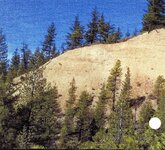

- Jan 1, 2013
- 2,657
- 5,428
- Detector(s) used
- Tesoro Vaquero, Whites MXT, Vsat, GMT, 5900Di Pro, Minelab GPX 5000, GPXtreme, 2200SD, Excalibur 1000!
- Primary Interest:
- All Treasure Hunting
Thanks for all that. No, we don't have to build the bluff face back. The area I was talking about with the purple material is a creek bluff. We have no interest in that area for now. We are permitted in the mining district 1/2 mile east of there. There is an exposed faultline richer than snot. Then there is another mine 2000 ft east which was partially hydraulicked with 1 million yards of pay left over in the gut of the channel. That 1 million yard figure only counts the pay streak which is about 40 ft thick from bedrock. The historical averages are 50 yds to the oz with best at bedrock but not always. I actually have a letter from the mining company from the 1800's describing what they were getting & they were hitting pay at various levels. They had trouble mining very far into summer as the flumes dried up. We are starting on the exposed material on the faultline as there is no overburden to deal with. We have about 50,000 yards of it & that should fund phase 2 at the big bluff. It better or I'm screwed LOL. Everything I own is riding on it. No guts, no glory.View attachment 1535211
Unfortunately, this pick does not look like a good paying channel at all unless it is below the trees and can't be seen. Most of the hydraulic mines around here started drift mining the channels but this area is full of blue channel. Either way, do you have a drilling and blasting expert or two? They blasted the cemented channels first as good as they could before they even hit the cemented gravels with water. I have an old series on hydraulic mining, if you haven't seen it already, the first 4 movies have some good teaching here and there...
https://m.youtube.com/playlist?list=PL34DA41102B4C46D3
OP
OP
ghostminer
Guest
- Thread starter
- #58
OP
OP
ghostminer
Guest
- Thread starter
- #59
Top Member Reactions
-
 3480
3480 -
 1986
1986 -
 1912
1912 -
 1160
1160 -
 1090
1090 -
 1010
1010 -
 889
889 -
 864
864 -
 860
860 -
 795
795 -
 759
759 -
 676
676 -
 659
659 -
 567
567 -
 508
508 -
 453
453 -
 447
447 -
 410
410 -
 401
401 -
E
398
Users who are viewing this thread
Total: 2 (members: 0, guests: 2)
